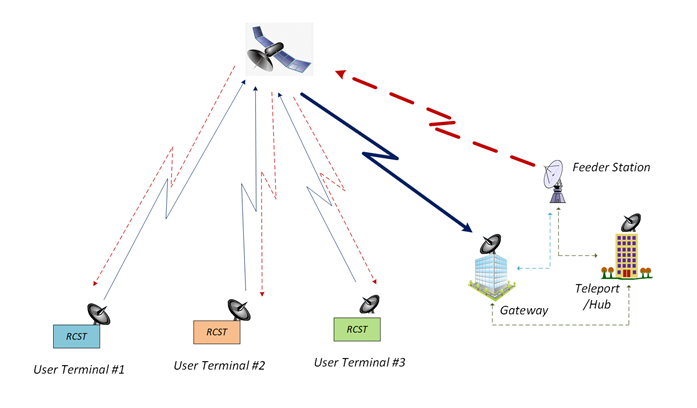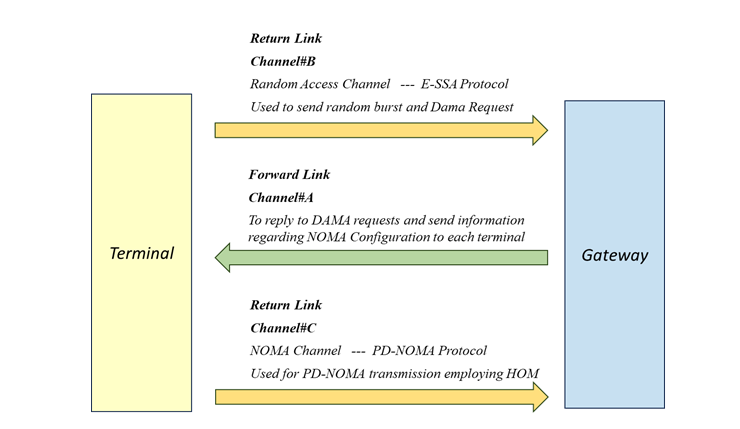-
StatusOngoing
-
Status date2024-04-22
-
Activity Code3C.024
- NOMA Techniques Development: The main purpose is the development and evaluation of NOMA (Non-Orthogonal Multiple Access) techniques for satellite return links, comparing performance with classical orthogonal access techniques.
- Software Defined NOMA techniques Testing by means of a test bed which includes software-defined NOMA transmitter and receiver (SDR)
- Throughput improvement: increasing the aggregate system return link throughput using NOMA over OMA
- Latency reduction: reduction in overall system latency with respect to OMA
- TRL up-scale: raising the Technology Readiness Level from current value TRL3 to TRL5
- Implementation and testing of Successive Interference Cancellation (SIC) at the gateway for High Order Modulations (HOM).
- Characterisation of the different impairments that could impact the effectiveness of NOMA methodologies and identification of corresponding realistic and accurate models
- Analysis and tuning of several algorithms (e.g., estimation algorithms) in order to deal with the different characteristics of the received signals
- Identification of scheduling strategies at system level for a commercial solution, trying to minimise the impact in terms of complexity compared to existing OMA solutions
- Overall increase in aggregate throughput and reduction in transmission latency compared to current OMA orthogonal access techniques
- Minimal impact in complexity at terminal level
- Possibility of integration into existing standards such as DVB-RCS
- Possibility to exploit current imbalances in terms of SNR in reception due to a variegated population of terminals
- Applicability to different types of services (low rate to high rate), as the protocol is independent of the signal bandwidth
- Implementation of High Order Modulations at both terminal and gateway sides
- Flexibility of the air-interface in terms of MODCOD to have the necessary granularity in terms of demodulation SNR thresholds
- Successive interference cancellation for High Order Modulations at gateway-side
- Operation with different types of terminals, including airborne ones
- Grant-based resource request by the terminal
At architecture level, the system involves a number of terminals, a gateway to receive information from the terminals, a feeder link to send information to the terminals, and a HUB to manage communication, as shown in the following figure.

The following figure shows in detail the channels allocated on the forward link and return link, both for the DAMA initial procedure and for transmission with PD-NOMA.

The developed NOMA techniques will be implemented in a software-defined NOMA transmitter and receiver (SDR), resulting in performance testing. A logical diagram of the air interface is shown below.

The digital section foresees a turbo encoding of the incoming data with a certain rate and a subsequent modulation, then the burst is created according to a pre-established configuration in terms of preamble sequence, TFI and pilot, finally a digital SRRC filter is applied to the digital signal.
The following figure shows a high-level diagram of the receiver.

In this stage the signal with the highest SNR is first acquired and demodulated, then this is cancelled to allow processing of the following one and so on until the last signal component to be demodulated.
The project plan foresees a unique phase which includes the following milestones after the KO meeting (T0):
- System Requirement Review (T0+3M)
- Critical Design Review (T0+8M)
- Test Readiness Review (T0+15M)
- Final Review (T0+18M)
The total duration of the project is 18 months.
Conclusion of activities related to WP0100, WP0200, WP1100, WP1200, regarding survey and critical assessment of the state-of-the-art of NOMA technologies, definition of System scenarios, use cases, technical requirements and preliminary verification plan. After the successful conclusion of SRR milestone, the activities related to WP2100, WP2200 and WP3100, which deals with the technology trade-off and detailed design of the baseline solution, are going to start.




